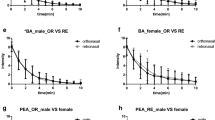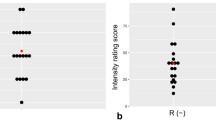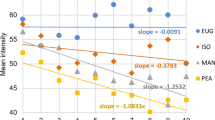Abstract
Aim
Ortho- and retronasal olfaction represent two aspects of a shared sensory system yet evoke different sensations. The differences between ortho- and retronasal olfaction have triggered a number of studies during the past years, which pointed towards a decreased sensitivity to odors presented through the retronasal olfactory pathway. Especially intensity was reported to be lower after retronasal olfactory stimulation. The aim of this study was to investigate how this compares to activation at the level of the olfactory epithelium in humans.
Methods
Trigeminal (CO2) and olfactory (H2S, phenylethyl alcohol) stimuli were presented ortho- and retronasally. Electro-olfactograms (EOG) in response to chemosensory stimulation were recorded in 10 participants (6 women, 4 men, mean age 23.4 years).
Results
Typical EOGs were demonstrable after either orthonasal or retronasal stimulation across the stimulus qualities. Overall, EOG amplitudes to retronasal stimulation were smaller when compared to those to orthonasal stimulation, but a significant difference was obtained only in phenylethyl alcohol (p = 0.048).
Conclusions
The present data indicate that the perceptual differences between ortho- and retronasal olfaction may start at the level of the olfactory epithelium. The data support the idea that the intensity of physically identical stimuli is lower after retronasal stimulation compared to orthonasal stimulus presentation for both olfactory and trigeminal stimuli.
Implications
The current electrophysiological results are in line with reported differences in psychophysical properties of retro- and orthonasal stimulations meaning that different sensations are elicit through these two channels although the same molecule is presented.

Similar content being viewed by others
References
Buettner A, Beer A, Hannig C, Settles M (2001) Observation of the swallowing process by application of videofluoroscopy and real-time magnetic resonance imaging-consequences for retronasal aroma stimulation. Chem Senses 26:1211–1219
Burdach KJ, Doty RL (1987) The effects of mouth movements, swallowing, and spitting on retronasal odor perception. Physiol Behav 41:353–356
Burdach KJ, Kroeze JH, Koster EP (1984) Nasal, retronasal, and gustatory perception: an experimental comparison. Percept Psychophys 36:205–208
Chapuis J, Messaoudi B, Ferreira G, Ravel N (2007) Importance of retronasal and orthonasal olfaction for odor aversion memory in rats. Behav Neurosci 121:1383–1392
Chapuis J, Garcia S, Messaoudi B, Thevenet M, Ferreira G, Gervais R, Ravel N (2009) The way an odor is experienced during aversive conditioning determines the extent of the network recruited during retrieval: a multisite electrophysiological study in rats. J Neurosci 29:10287–10298
Dalton P, Doolittle N, Nagata H, Breslin PA (2000) The merging of the senses: integration of subthreshold taste and smell. Nat Neurosci 3:431–432
Damm M, Vent J, Schmidt M, Theissen P, Eckel HE, Lotsch J, Hummel T (2002) Intranasal volume and olfactory function. Chem Senses 27:831–839
Damm M, Eckel HE, Jungehulsing M, Hummel T (2003) Olfactory changes at threshold and suprathreshold levels following septoplasty with partial inferior turbinectomy. Ann Otol Rhinol Laryngol 112:91–97
Doty RL, Brugger WPE, Jurs PC, Orndorff MA, Snyder PJ, Lowry LD (1978) Intranasal trigeminal stimulation from odorous volatiles: psychometric responses from anosmic and normal humans. Physiol Behav 20:175–185
Frasnelli J, Heilmann S, Hummel T (2004) Responsiveness of the human nasal mucosa to trigeminal stimuli depends on the site of stimulation. Neurosci Lett 362:65–69
Gautam SH, Verhagen JV (2010) Evidence that the sweetness of odors depends on experience in rats. Chem Senses 35:767–776
Gautam SH, Verhagen JV (2012a) Direct behavioral evidence for retronasal olfaction in rats. PLoS One 7, e44781
Gautam SH, Verhagen JV (2012b) Retronasal odor representations in the dorsal olfactory bulb of rats. J Neurosci 32:7949–7959
Getchell TV, Getchell ML (1991) Peripheral mechanisms of olfaction: biochemistry and neurophysiology. In: Finger TE, Silver WL (eds) Neurobiology of taste and smell. Krieger Publishing Company, Malabar, pp 91–123
Halpern BP (2004) Retronasal and orthonasal smelling. Chem Senses 6:1–7
Heilmann S, Hummel T (2004) A new method for comparing orthonasal and retronasal olfaction. Behav Neurosci 118:412–419
Hummel T, Pietsch H, Kobal G (1991) Kallmann’s syndrome and chemosensory evoked potentials. Eur Arch Otorhinolaryngol 248:311–312
Hummel T, Heilmann S, Landis BN, Reden J, Frasnelli J, Small DM, Gerber J (2006) Perceptual differences between chemical stimuli presented through the ortho- or retronasal route. Flavor Fragr J 21:42–47
Knecht M, Hummel T (2004) Recording of the human electro-olfactogram. Physiol Behav 83:13–19
Kobal G (1981) Elektrophysiologische Untersuchungen des menschlichen Geruchssinns. Thieme Verlag, Stuttgart
Kobal G, Hummel C (1988) Cerebral chemosensory evoked potentials elicited by chemical stimulation of the human olfactory and respiratory nasal mucosa. Electroenceph Clin Neurophysiol 71:241–250
Landis BN, Giger R, Ricchetti A, Leuchter I, Hugentobler M, Hummel T, Lacroix JS (2003) Retronasal olfactory function in nasal polyposis. Laryngoscope 113:1993–1997
Lang J (1989) Clinical anatomy of the nose, nasal cavity and paranasal sinuses. Thieme, Stuttgart
Lapid H, Hummel T (2013) Recording odor-evoked response potentials at the human olfactory epithelium. Chem Senses 38:3–17
Lapid H, Seo HS, Schuster B, Schneidman E, Roth Y, Harel D, Sobel N, Hummel T (2009) Odorant concentration dependence in electroolfactograms recorded from the human olfactory epithelium. J Neurophysiol 102:2121–2130
Ottoson D (1956) Analysis of the electrical activity of the olfactory epithelium. Acta Physiol Scand 35:1–83
Pierce J, Halpern BP (1996) Orthonasal and retronasal odorant identification based upon vapor phase input from common substances. Chem Senses 21:529–543
Raudenbush B, Meyer B (2001) Effect of nasal dilators on pleasantness, intensity and sampling behaviors of foods in the oral cavity. Rhinology 39:80–83
Rebello MR, Kandukuru P, Verhagen JV (2015) Direct behavioral and neurophysiological evidence for retronasal olfaction in mice. PLoS One 10, e0117218
Rozin P (1982) “Taste–smell confusions” and the duality of the olfactory sense. Percept Psychophys 31:397–401
Scott JW, Acevedo HP, Sherrill L, Phan M (2007) Responses of the rat olfactory epithelium to retronasal air flow. J Neurophysiol 97:1941–1950
Scott JW, Sherrill L, Jiang J, Zhao K (2014) Tuning to odor solubility and sorption pattern in olfactory epithelial responses. J Neurosci 34:2025–2036
Small DM, Gerber JC, Mak YE, Hummel T (2005) Differential neural responses evoked by orthonasal versus retronasal odorant perception in humans. Neuron 47:593–605
Thiele V, Kobal G (1984) Vergleich der objektiven und subjektiven Methoden olfaktometrischer Bestimmungen—Beispiel Schwefelwasserstoff. Schriftenreihe der Landesanstalt für Immissionsschutz des Landes NW 59:41–47
Author information
Authors and Affiliations
Corresponding author
Ethics declarations
Funding
This study was funded by a grant from the Deutsche Forschungsgemeinschaft to TH (DFG HU441/18-1).
Conflict of Interest
The authors declare that they have no conflict of interest.
Ethical Approval
All procedures performed in studies involving human participants were in accordance with the ethical standards of the institutional and/or national research committee and with the 1964 Helsinki declaration and its later amendments or comparable ethical standards.
Informed Consent
Informed consent was obtained from all individual participants included in the study.
Rights and permissions
About this article
Cite this article
Hummel, T., Seo, HS., Pellegrino, R. et al. Electro-Olfactograms in Humans in Response to Ortho- and Retronasal Chemosensory Stimulation. Chem. Percept. 10, 114–118 (2017). https://doi.org/10.1007/s12078-016-9217-z
Received:
Accepted:
Published:
Issue Date:
DOI: https://doi.org/10.1007/s12078-016-9217-z




